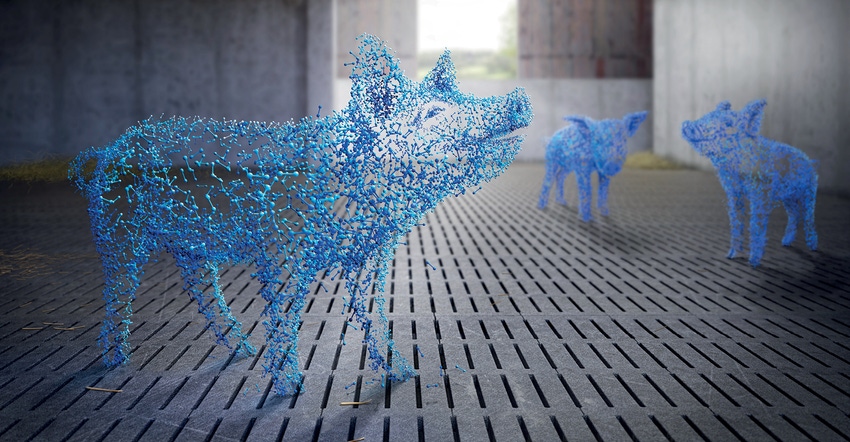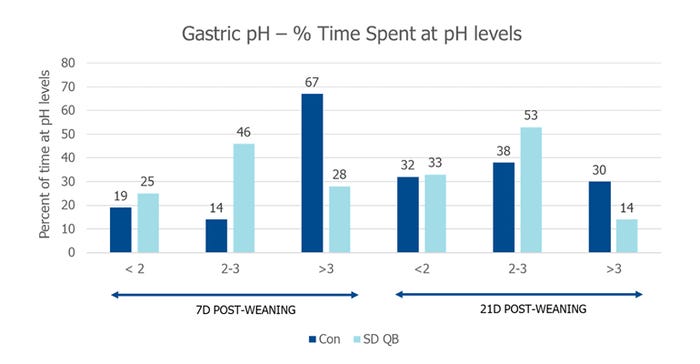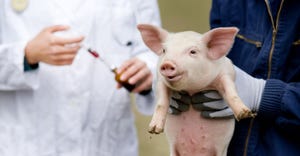Addition of superdosing levels of phytase
The addition of phytase at superdosing levels (>2,000 FTU/kg) is well-proven when it comes to nursery pigs.
June 1, 2022

Sponsored Content
Authors: Dr. Laura Merriman, Dr. Gustavo Cordero and Dr. Pete Wilcock
The addition of phytase at superdosing levels (>2,000 FTU/kg) is well-proven when it comes to nursery pigs. Young piglets are subjected to many challenges at this critical time in development and maximizing nutrient utilization is a clear advantage to helping get them off on the right growth trajectory. Based on 50 comparisons with nursery piglets, the ADG (+8%; Figure 1) and FCR (-5%; not shown) are consistently improved (>90% positive response) when higher levels of phytase are added to the diet.
Figure 1. Improvements in ADG in nursery pigs fed diets containing superdosing levels (> 2000 FTU/kg) of phytase (Quantum Blue, AB Vista) above a control diet

The additon of phytase results in the hydrolysis of the phytate molecule, an antinutrient, and liberates those nutrients bound to the molecule. Consequently, increasing phytase supplementation increases the digestibility of minerals such as Ca, P, Na, Zn, Fe and Cu, as well as amino acids, while improving efficiency of energy utilization. When superdosing, it is critical to select a phytase that targets fast phytate and, more critically, lower phytate ester destruction, resulting in a higher level of inositol production (Holloway et al., 2016 and Moran et al., 2019). Inositol is thought to play a role in glucose transport, lipid metabolism, antioxidant status and other metabolic functions. Although there is no known nutritional requirement for inositol in swine, inositol supplementation can improve post-weaning pig performance in nursery pigs, and a similar level of performance benefit may be achieved by superdosing phytase (Moran, 2019). The strategy of application of superdosing phytase in nursery pigs on top of the diet with no matrix or a mineral matrix supports enhanced nutrient utilization and additional growth in the animal. This also provides the piglet with the best opportunity to maximize its early growth potential and, thereby, subsequent lifetime performance.
Recent work may provide potential additional insights into the advantages observed when adding higher levels of phytase in the nursery. In this work, the researchers were able to utilize pH capsules that are able to measure real-time gastric pH for approximately a three-hour time frame, during which pH readings are taken each second with averages recorded every five minutes. In part of a larger study, Lee et al. (2021), evaluated the effects of adding superdosing levels of phytase for the first 21 days after weaning. In this study, superdosing phytase reduced (P < 0.01) pH at both the 7- and 21-day post-weaning time points, from an average of 3.27 to 2.62 and from 4.73 in the controls to 3.76 with superdosing, respectively. Real-time pH readings allowed the researchers to quantify the time at specific pH ranges, which showed that phytase shifts the gastric environment to a more acidic environment, with more time spent at pH less than 3 (Figure 2), and some pigs spending time at pH less than 2, especially at 7 days post-weaning.
Figure 2. The proportion of time spent at various pH levels in the stomach of pigs at 7 and 21 days post-weaning when fed diets without or with superdosing levels of phytase (Quantum Blue; AB Vista)

A reduction in pH is indicative of hydrochloric acid secretion in the stomach of the animal, which supports better digestion (pepsin activity peaks at pH 2-3.5) and, ultimately, absorption by the animal. Improving protein digestibility reduces the level of undigested protein entering the small intestine, and thereby improves feed efficiency and reduces the ability of opportunistic pathogens such as E. coli to thrive. This potential new action of superdosing phytase should be explored further as it may, in part explain, the observed response of more efficiency of pigs fed phytase (FCR, 8 points lower; P < 0.05) and 0.6 kg heavier piglet weight at 21 days. It can also provide an insight into previous data that has shown that superdosing phytase can help reduce post-weaning diarrhea (Walk et al., 2014; Moran et al., 2017). Other research (Lee et al., 2018; Lagos et al., 2021), whereby increasing or high levels of phytase reduces the gastric pH in nursery pigs, supports this approach as well.
Conclusion
The use of superdosing phytase in nursery pigs for improved post-weaning and nursery performance is well-proven and can be attributed to the improved nutrient utilization of minerals, amino acids and energy associated with the destruction of dietary phytate and lower phytate esters. It is also linked to the generation of inositol, which may play an important role in the immediate period post-weaning. Finally, a number of recent studies have shown that superdosing phytase can reduce gastric pH, which benefits newly weaned pigs through improved protein digestion. This may be an additional factor in the way phytase can improve nursery pig performance and should be investigated further.
About the Author(s)
You May Also Like



